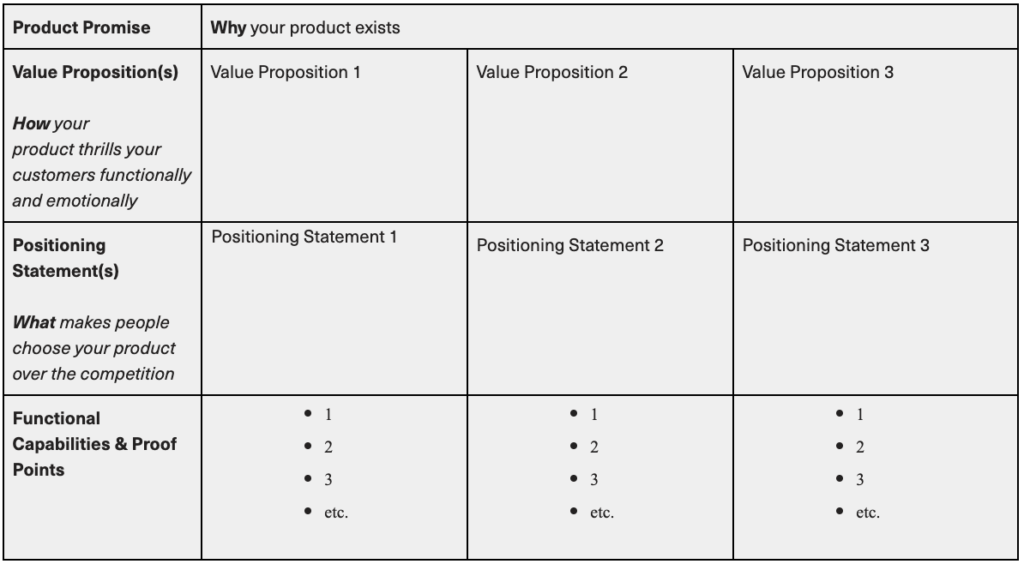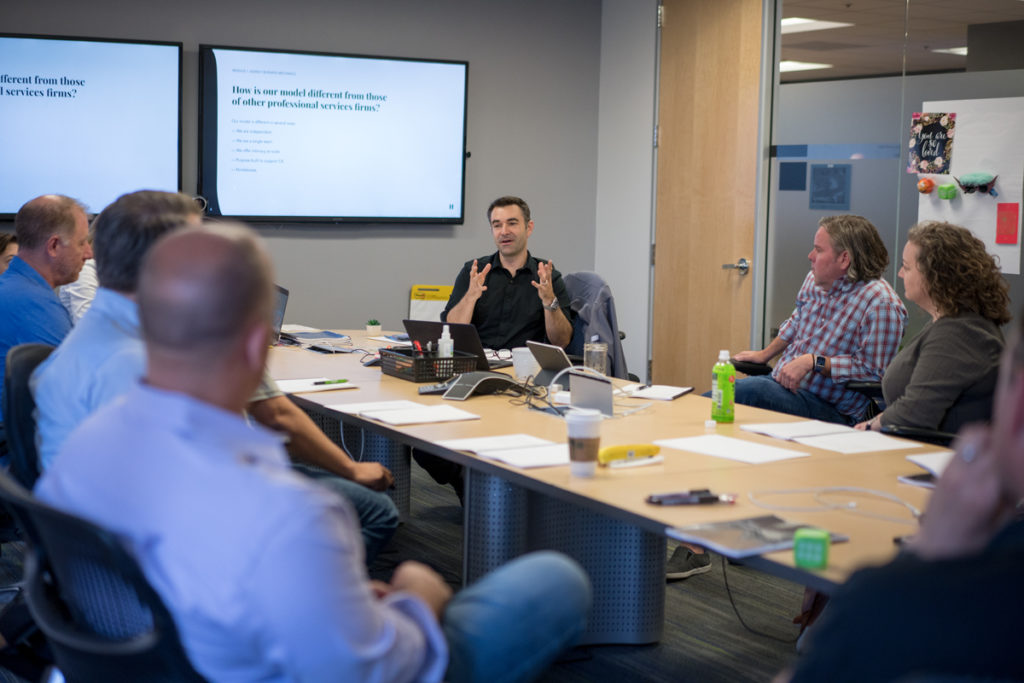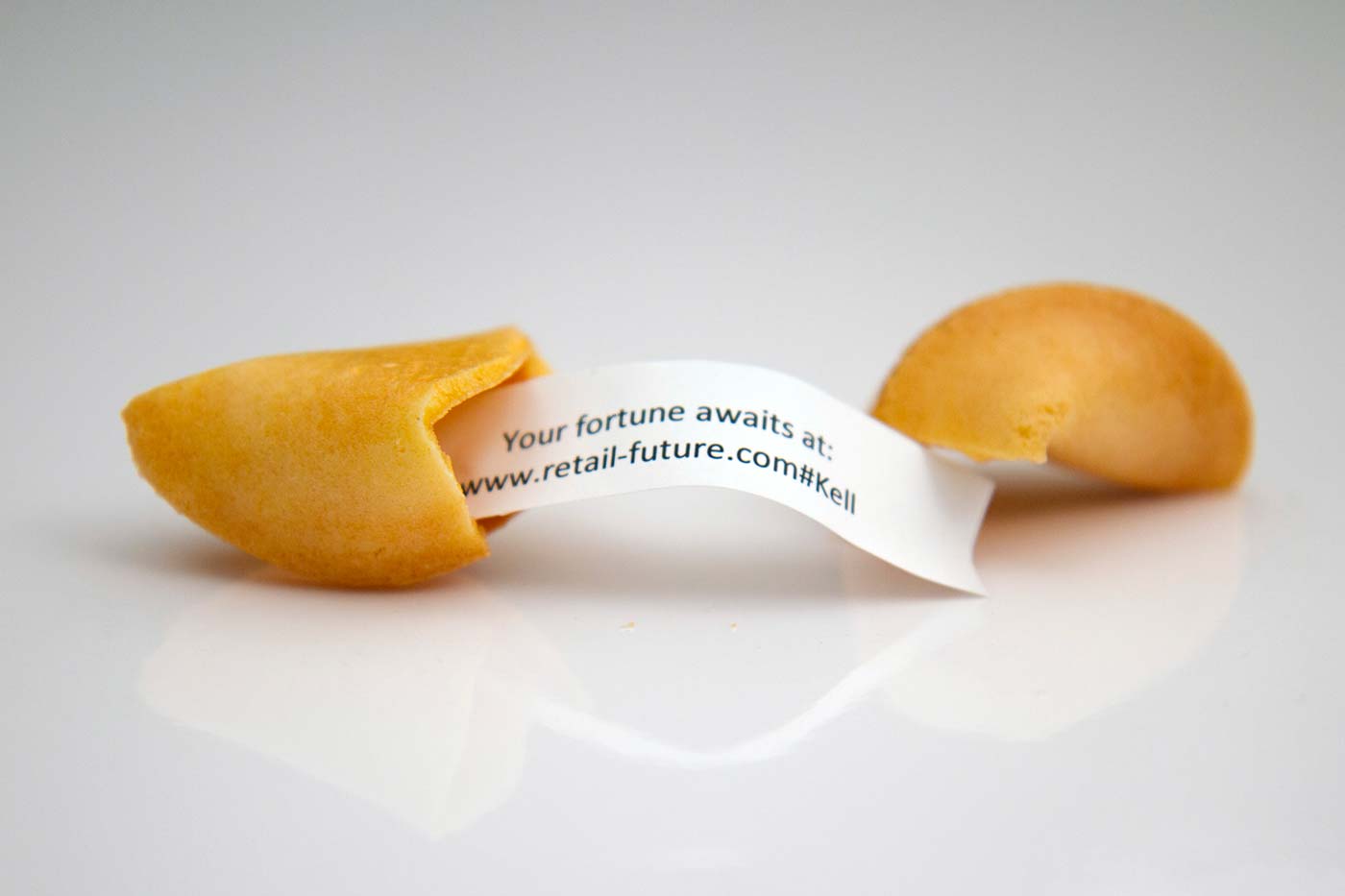When you think about B2B campaigns, what comes to mind? Product-focused messaging written in sales-speak? One-off campaigns that don’t impact business goals or address customer needs?
It doesn’t have to be this way. From launching new products to building out marketing campaigns, savvy B2B marketers know there’s a business with a problem behind every purchase. The best B2B marketers build their messaging and marketing campaigns around solving those problems.
Below, you’ll find our five-step process for identifying key customer insights, untangling the buyer’s journey, and building full-funnel B2B messaging strategies.
Step 1: Start a Conversation
Before you start planning campaigns or writing product copy, it’s critical to first understand who your audience is. Ideally, you should have personas. But whether or not you do, it’s critical to start a conversation with your audience.
Here, your current customers can play a role. They offer a great look into what the buyer’s journey looks like, as well as how that experience unfolds before, during, and after the big purchase.
But you don’t just want to know what customers think. You also want to know what prospective customers think—and why they might choose one client over another to make a purchase decision.
When it comes to getting to know your target audience, there’s no substitute for direct conversation. And there are a few ways to talk to your customers directly.
Audience Interviews
Direct interviews can provide powerful insights into customer experiences with your brand and products. “Interviews are a great way to go deep into the needs of a specific persona or customer type,” Atlassian says. “You get to ask specific questions that’ll generate information you need to make decisions about your product or service.”
It’s important to remember that interviews are a two-way street. You need to ask the right people the right questions—that includes customers who had great experiences with your products and customers who had bad experiences with your products.
Online Surveys
With online tools like SurveyMonkey and SurveyGizmo, it’s easier to conduct large-scale customer surveys on everything from brand perception to customer sentiment. Other resources such as Google Surveys make it easy to target specific audiences and quickly do on-the-fly market research.
You can also use third-party market research firms. Though more expensive, these firms often produce high-quality, scientifically rigorous surveys that can better shine a light on key insights about your target customers.
Email Questionnaires
If you can’t conduct an interview or online survey, email questionnaires are your next best bet. They allow you to capture more candid feedback than you might get over social media or other online platforms. That’s because you can ask specific questions and personalize the messaging based on your needs. That doesn’t mean email is a substitute for direct interviews, but individual emails can offer valuable information and open a direct communication line with your customers.
Focus Groups
If you want to go all in, focus groups are a great way to really dig into what your target audience wants—and what keeps them up at night. Unlike scripted surveys or one-off direct emails, focus groups allow conversations to organically take shape under the direction of a moderator. They consequently tend to offer up more nuanced and multi-dimensional feedback.
Focus groups are often more cost-prohibitive than other forms of customer research but can turn up the most robust qualitative insights about your customers’ pain points, the buyer’s journey, and their experience with your products and brand.
If you can’t do any of these, then you should at least listen to the conversation. With online review sites such as G2 and professional networks like Spiceworks for IT professionals, today’s B2B marketers have a plethora of low-cost ways to connect with their customers and engage in social listening.
This means tuning into conversations that are already happening, and drilling into what people are saying and where they’re saying it. While it can complement direct outreach, it’s not a substitute for real conversations.
Step 2: Ask the Right Questions
However you connect with your customers, you need to be laser-focused on asking the right questions. There are key pieces of information you’re looking for—pain points, where they did research before making a purchase decision, etc.—and you need to ask the right questions to uncover them.
Here are some starter questions to consider as you prepare:
- What does the customer care about?
- What are they trying to accomplish, and what’s the roadblock?
- What conditions, restrictions, or challenges are they up against?
- Where do they go for information to research solutions?
- Do they already know your company and/or product?
- What competitors did they consider?
- Do they know how your product or service can help them overcome their challenge?
The answers to these questions can uncover key insights about the buyer’s journey and what your target audience cares about. They can also underscore gaps in customer knowledge around your brand, products, and/or services, which is critical information when developing campaign messaging and overall strategy.
But the goal here is to learn more about your target customers by digging into what they care about, what keeps them up at night, and where they go to find solutions to their problems.
Step 3: Untangle the Buyer’s Journey
Now comes the fun part: Untangling the buyer’s journey.
The buyer’s journey is generally divided into three parts: the awareness, consideration, and decision stages. But it’s rarely linear. Today’s customer often starts and stops on the path to purchase, switching between channels such as email, Google, sales calls, and product pages multiple times before making a buying decision.
That means it’s better to treat the buyer’s journey as a holistic experience: No matter where your target customer is, they should have the content, resources, and support they need to choose your solution.
As you think through the ideal path your target customer will take to purchase, there are some key questions you’ll want to ask:
- How are you generating awareness around your products?
- What places—trade publications, websites, forums, etc.—do your target customers look to for information?
- How many touchpoints—the places your target customers engage with you—are you reaching?
- How are your target customers finding information to choose you over your competitors?
Answering these questions will guide you through the entire buyer’s experience from the moment someone realizes they have a problem to the initial encounter with your brand and products/services to the final buying decision.
Step 4: Know Your Value (And Prove It)
Once you understand what matters to your audience, you can begin aligning your products, services, and solutions with customer pain points and the buyer’s journey. This is where you explore how your product addresses your audience’s needs, and what features, services, and/or benefits are differentiated from the competition.
The goal here is to detail the key values, functional benefits, and unique capabilities and use cases of your products and services. Think through the following questions when defining your value:
- How does your product solve your customers’ and prospects’ particular problems?
- What can your product or service do for them that your competition can’t?
- How will your product or service help customers achieve their goals or engage more meaningfully with what they care about?
Once answered, distill these ideas down to specific, concise statements that sum up why your products exist, and why people choose you over your competitors.
You can then begin to sort these statements—otherwise known as value propositions—into a messaging platform, or messaging hierarchy, that might look something like the chart below.

Step 5: Develop a Message Map
Now that you’re equipped with information about your audience and how your products can uniquely benefit them, it’s time to get down to brass tacks. This is where messaging strategy and content converge in the form of a message map, which ties specific content assets to key messages, value propositions, and audience pain points.
Unlike a messaging platform which gives messaging strategy, a message map is a tactical framework for building specific messages for specific touchpoints.
There are four major steps to creating an effective message map:
1. Define the objective for your campaign.
From existing customers to Marketing VPs to IT professionals, think through who you will be targeting and to what end. Your objectives will depend on the products or services you’re marketing—and who you’re marketing them to.
2. Determine your key touchpoints and channels.
Different target audiences will turn to different touchpoints and channels on the buyer’s journey, and that makes it critical to identify where your target audience(s) is most likely to be so you can plan accordingly. Identify key publications, websites, and other touchpoints so you can reach your target audience(s).
3. Make an inventory of your content and assets for the campaign.
Build an inventory of all your key assets that work for this specific campaign, and then segment them out by the part of the buyer’s journey they ladder up to. Some of your content will be more geared toward creating awareness around your products or services, while some assets—think case studies, for instance—will be more geared to helping someone choose you over the competition.
4. Map your key messages and content to your touchpoints.
Depending on where a prospect is in the buyer’s journey, they’ll be looking for different information—and going to different places to find it. Consequently, you’ll want to map your key messages to different touchpoints along the buyer journey to ensure people find the right content at the right time in the right place.
Once you’ve built out your communication and messaging strategies, you can begin to build out your message map and campaigns. The goal here is to align your key messages to key customer touchpoints—and develop a roadmap for building out communications and campaigns.
The Bottom Line
The best B2B messaging strategies aren’t created in a vacuum. They require insightful customer research, consistent messaging, and a strong understanding of customer needs. Savvy marketers know there’s a business problem behind every purchase—and connecting real solutions to those problems is the best way to turn prospects into customers.
Whether you’re just digging into customer research or building out audience-specific messages, here are three takeaways to keep in mind when building B2B messaging strategies.
1. Know your target audience.
Customer research is key to determining who you’re selling to, how they’re finding you, and why they chose you over the competition. Start by talking to prospects, your current customers, and your sales team, and make sure to ask the right questions that inform how to turn prospects into customers.
2. The B2B buyer journey starts with a business problem.
In B2B, it’s rare for buying committees to buy products or services on a whim. They buy real solutions for real problems. Identify the key problems your products solve for—and dig deep into your customer research to make sure you’re covering all of your bases.
3. Consistent messaging requires careful planning.
From emails to white papers to conferences, there are dozens of touchpoints you can influence with a marketing campaign—it’s critical to make sure you have a consistent messaging strategy across all of them. Use organizational tools such as messaging platforms and message maps to ensure consistency.
—
Don’t want to go it alone? Contact us to learn how we can help you with strategic messaging platforms, campaigns, and content.








